Report on Obesity in Ealing: Social Determinants & Strategies
VerifiedAdded on 2023/06/18
|12
|3854
|138
Report
AI Summary
This report examines the public health issue of obesity in Ealing, UK, focusing on its social determinants and the resulting health inequalities. It identifies key social determinants such as economic stability, education, neighborhood environment, and social community factors that contribute to obesity rates in the area. Using the Dahlgren-Whitehead Rainbow Model, the report explores the relationship between these determinants and health inequalities, highlighting how individual lifestyles, social networks, and socio-economic conditions exacerbate the problem. The report further identifies and evaluates strategies to address these local health inequalities, emphasizing the need for interventions that consider social, medical, and psychosocial factors to promote healthier lifestyles and reduce obesity rates in Ealing. This analysis provides a comprehensive overview of the complex factors driving obesity and offers insights into potential solutions for improving public health outcomes.
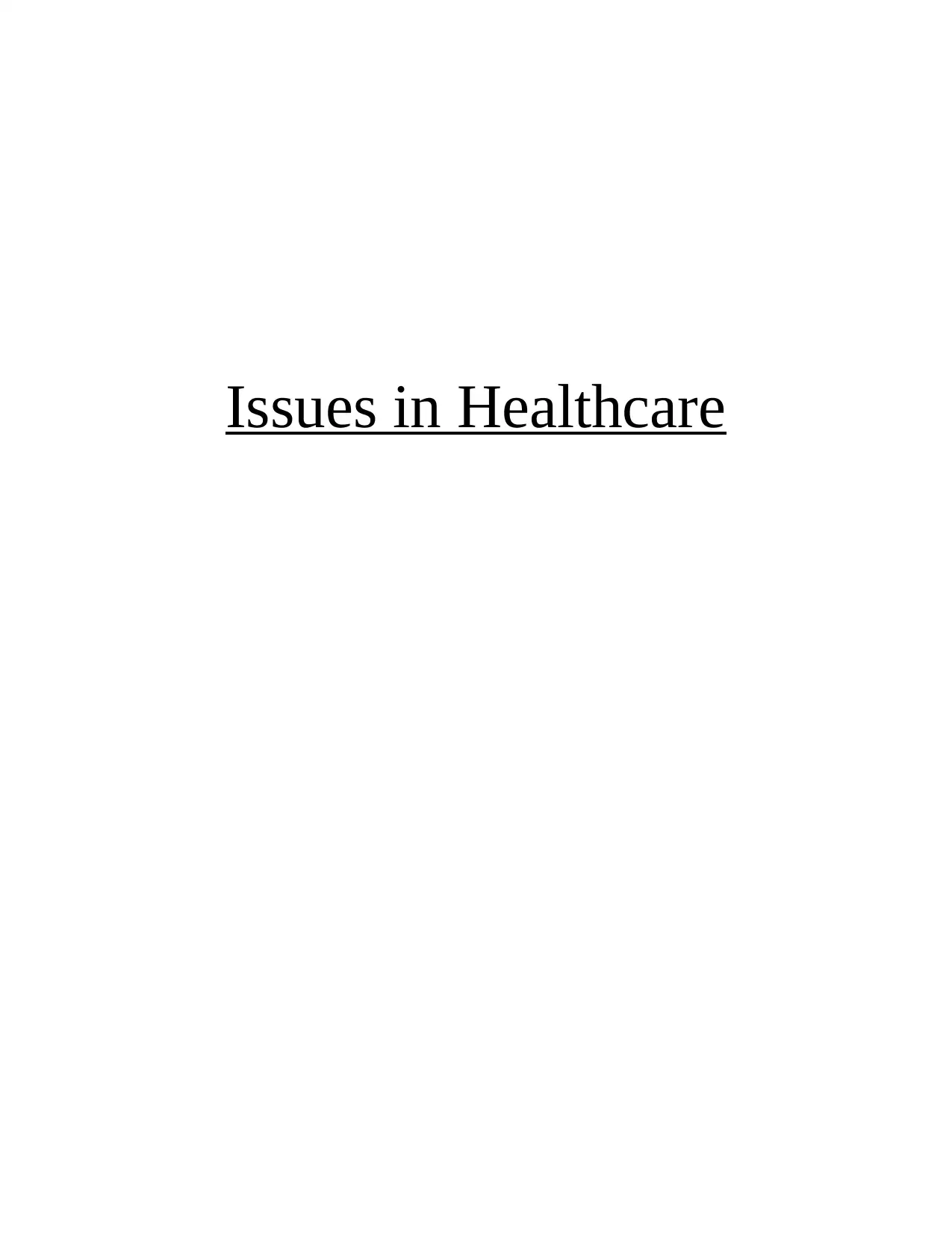
Issues in Healthcare
Paraphrase This Document
Need a fresh take? Get an instant paraphrase of this document with our AI Paraphraser
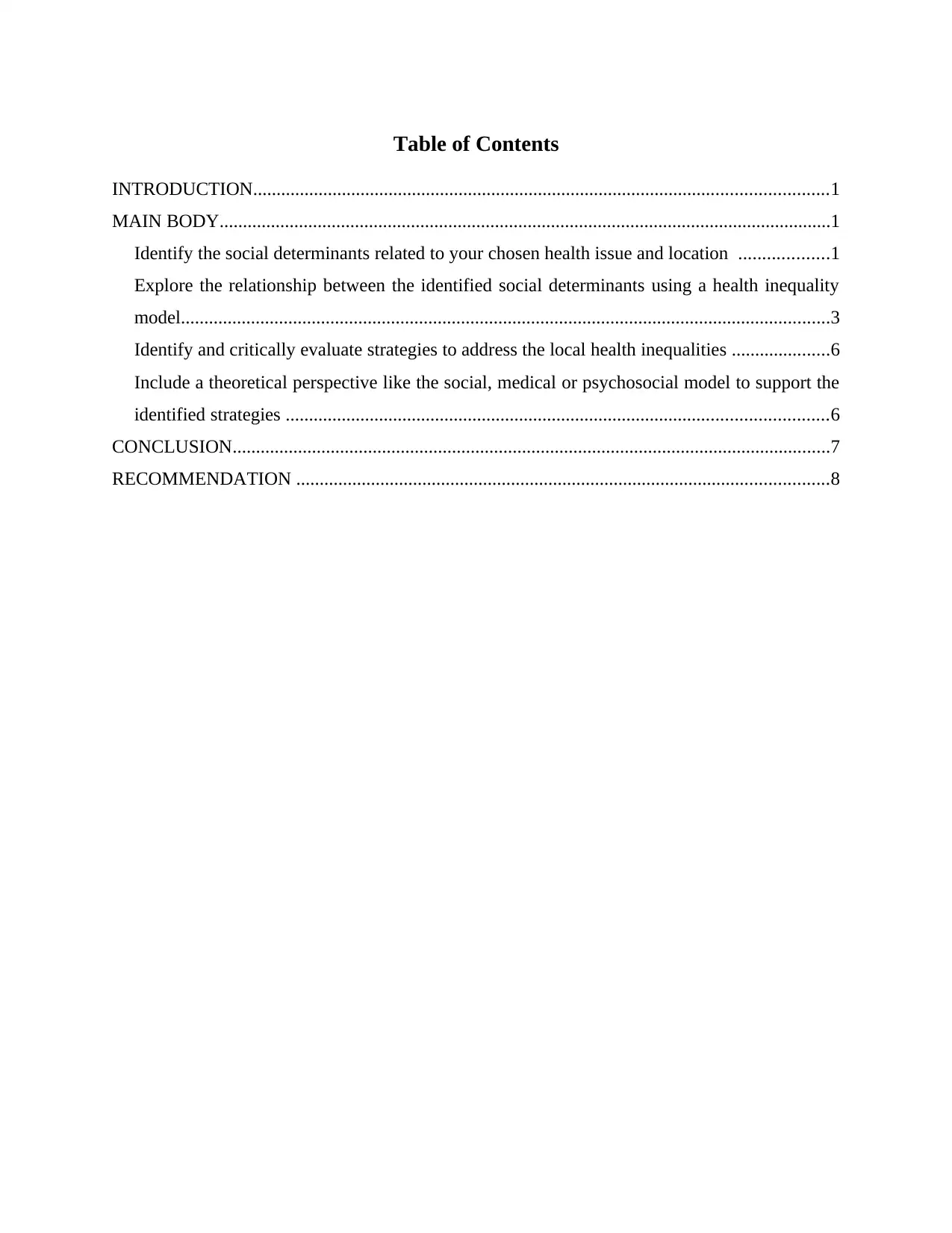
Table of Contents
INTRODUCTION...........................................................................................................................1
MAIN BODY...................................................................................................................................1
Identify the social determinants related to your chosen health issue and location ...................1
Explore the relationship between the identified social determinants using a health inequality
model...........................................................................................................................................3
Identify and critically evaluate strategies to address the local health inequalities .....................6
Include a theoretical perspective like the social, medical or psychosocial model to support the
identified strategies ....................................................................................................................6
CONCLUSION................................................................................................................................7
RECOMMENDATION ..................................................................................................................8
INTRODUCTION...........................................................................................................................1
MAIN BODY...................................................................................................................................1
Identify the social determinants related to your chosen health issue and location ...................1
Explore the relationship between the identified social determinants using a health inequality
model...........................................................................................................................................3
Identify and critically evaluate strategies to address the local health inequalities .....................6
Include a theoretical perspective like the social, medical or psychosocial model to support the
identified strategies ....................................................................................................................6
CONCLUSION................................................................................................................................7
RECOMMENDATION ..................................................................................................................8

⊘ This is a preview!⊘
Do you want full access?
Subscribe today to unlock all pages.

Trusted by 1+ million students worldwide
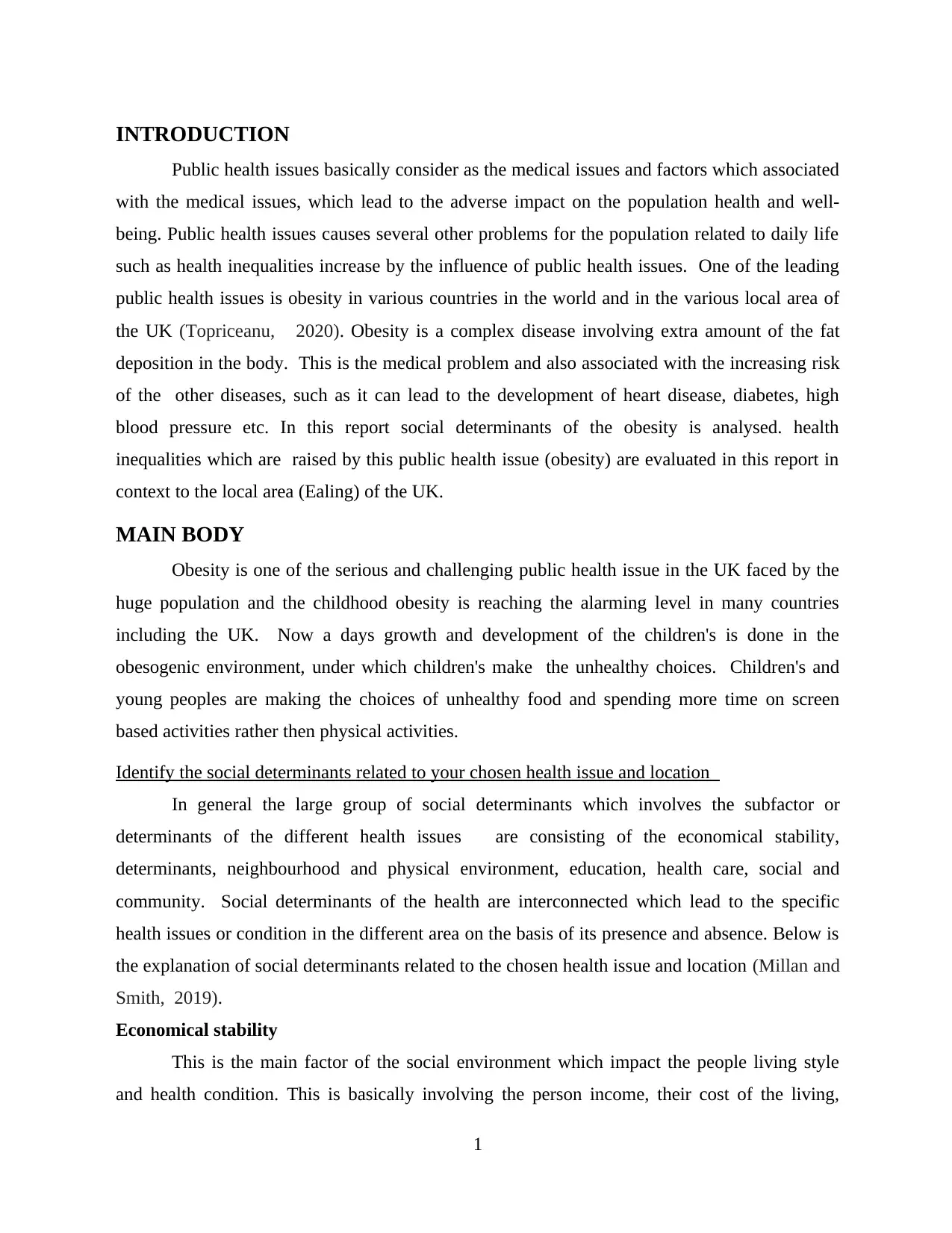
INTRODUCTION
Public health issues basically consider as the medical issues and factors which associated
with the medical issues, which lead to the adverse impact on the population health and well-
being. Public health issues causes several other problems for the population related to daily life
such as health inequalities increase by the influence of public health issues. One of the leading
public health issues is obesity in various countries in the world and in the various local area of
the UK (Topriceanu, 2020). Obesity is a complex disease involving extra amount of the fat
deposition in the body. This is the medical problem and also associated with the increasing risk
of the other diseases, such as it can lead to the development of heart disease, diabetes, high
blood pressure etc. In this report social determinants of the obesity is analysed. health
inequalities which are raised by this public health issue (obesity) are evaluated in this report in
context to the local area (Ealing) of the UK.
MAIN BODY
Obesity is one of the serious and challenging public health issue in the UK faced by the
huge population and the childhood obesity is reaching the alarming level in many countries
including the UK. Now a days growth and development of the children's is done in the
obesogenic environment, under which children's make the unhealthy choices. Children's and
young peoples are making the choices of unhealthy food and spending more time on screen
based activities rather then physical activities.
Identify the social determinants related to your chosen health issue and location
In general the large group of social determinants which involves the subfactor or
determinants of the different health issues are consisting of the economical stability,
determinants, neighbourhood and physical environment, education, health care, social and
community. Social determinants of the health are interconnected which lead to the specific
health issues or condition in the different area on the basis of its presence and absence. Below is
the explanation of social determinants related to the chosen health issue and location (Millan and
Smith, 2019).
Economical stability
This is the main factor of the social environment which impact the people living style
and health condition. This is basically involving the person income, their cost of the living,
1
Public health issues basically consider as the medical issues and factors which associated
with the medical issues, which lead to the adverse impact on the population health and well-
being. Public health issues causes several other problems for the population related to daily life
such as health inequalities increase by the influence of public health issues. One of the leading
public health issues is obesity in various countries in the world and in the various local area of
the UK (Topriceanu, 2020). Obesity is a complex disease involving extra amount of the fat
deposition in the body. This is the medical problem and also associated with the increasing risk
of the other diseases, such as it can lead to the development of heart disease, diabetes, high
blood pressure etc. In this report social determinants of the obesity is analysed. health
inequalities which are raised by this public health issue (obesity) are evaluated in this report in
context to the local area (Ealing) of the UK.
MAIN BODY
Obesity is one of the serious and challenging public health issue in the UK faced by the
huge population and the childhood obesity is reaching the alarming level in many countries
including the UK. Now a days growth and development of the children's is done in the
obesogenic environment, under which children's make the unhealthy choices. Children's and
young peoples are making the choices of unhealthy food and spending more time on screen
based activities rather then physical activities.
Identify the social determinants related to your chosen health issue and location
In general the large group of social determinants which involves the subfactor or
determinants of the different health issues are consisting of the economical stability,
determinants, neighbourhood and physical environment, education, health care, social and
community. Social determinants of the health are interconnected which lead to the specific
health issues or condition in the different area on the basis of its presence and absence. Below is
the explanation of social determinants related to the chosen health issue and location (Millan and
Smith, 2019).
Economical stability
This is the main factor of the social environment which impact the people living style
and health condition. This is basically involving the person income, their cost of the living,
1
Paraphrase This Document
Need a fresh take? Get an instant paraphrase of this document with our AI Paraphraser
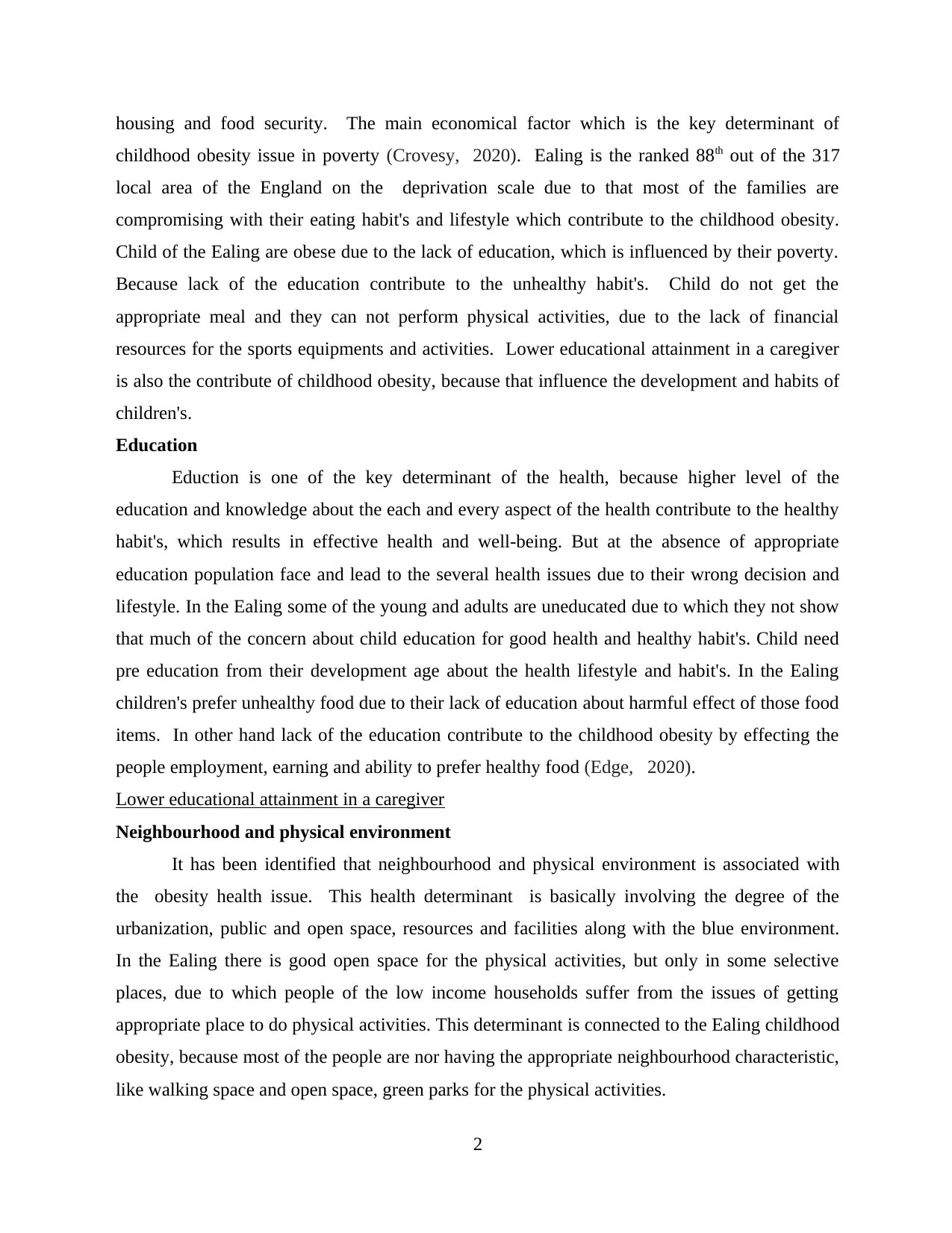
housing and food security. The main economical factor which is the key determinant of
childhood obesity issue in poverty (Crovesy, 2020). Ealing is the ranked 88th out of the 317
local area of the England on the deprivation scale due to that most of the families are
compromising with their eating habit's and lifestyle which contribute to the childhood obesity.
Child of the Ealing are obese due to the lack of education, which is influenced by their poverty.
Because lack of the education contribute to the unhealthy habit's. Child do not get the
appropriate meal and they can not perform physical activities, due to the lack of financial
resources for the sports equipments and activities. Lower educational attainment in a caregiver
is also the contribute of childhood obesity, because that influence the development and habits of
children's.
Education
Eduction is one of the key determinant of the health, because higher level of the
education and knowledge about the each and every aspect of the health contribute to the healthy
habit's, which results in effective health and well-being. But at the absence of appropriate
education population face and lead to the several health issues due to their wrong decision and
lifestyle. In the Ealing some of the young and adults are uneducated due to which they not show
that much of the concern about child education for good health and healthy habit's. Child need
pre education from their development age about the health lifestyle and habit's. In the Ealing
children's prefer unhealthy food due to their lack of education about harmful effect of those food
items. In other hand lack of the education contribute to the childhood obesity by effecting the
people employment, earning and ability to prefer healthy food (Edge, 2020).
Lower educational attainment in a caregiver
Neighbourhood and physical environment
It has been identified that neighbourhood and physical environment is associated with
the obesity health issue. This health determinant is basically involving the degree of the
urbanization, public and open space, resources and facilities along with the blue environment.
In the Ealing there is good open space for the physical activities, but only in some selective
places, due to which people of the low income households suffer from the issues of getting
appropriate place to do physical activities. This determinant is connected to the Ealing childhood
obesity, because most of the people are nor having the appropriate neighbourhood characteristic,
like walking space and open space, green parks for the physical activities.
2
childhood obesity issue in poverty (Crovesy, 2020). Ealing is the ranked 88th out of the 317
local area of the England on the deprivation scale due to that most of the families are
compromising with their eating habit's and lifestyle which contribute to the childhood obesity.
Child of the Ealing are obese due to the lack of education, which is influenced by their poverty.
Because lack of the education contribute to the unhealthy habit's. Child do not get the
appropriate meal and they can not perform physical activities, due to the lack of financial
resources for the sports equipments and activities. Lower educational attainment in a caregiver
is also the contribute of childhood obesity, because that influence the development and habits of
children's.
Education
Eduction is one of the key determinant of the health, because higher level of the
education and knowledge about the each and every aspect of the health contribute to the healthy
habit's, which results in effective health and well-being. But at the absence of appropriate
education population face and lead to the several health issues due to their wrong decision and
lifestyle. In the Ealing some of the young and adults are uneducated due to which they not show
that much of the concern about child education for good health and healthy habit's. Child need
pre education from their development age about the health lifestyle and habit's. In the Ealing
children's prefer unhealthy food due to their lack of education about harmful effect of those food
items. In other hand lack of the education contribute to the childhood obesity by effecting the
people employment, earning and ability to prefer healthy food (Edge, 2020).
Lower educational attainment in a caregiver
Neighbourhood and physical environment
It has been identified that neighbourhood and physical environment is associated with
the obesity health issue. This health determinant is basically involving the degree of the
urbanization, public and open space, resources and facilities along with the blue environment.
In the Ealing there is good open space for the physical activities, but only in some selective
places, due to which people of the low income households suffer from the issues of getting
appropriate place to do physical activities. This determinant is connected to the Ealing childhood
obesity, because most of the people are nor having the appropriate neighbourhood characteristic,
like walking space and open space, green parks for the physical activities.
2
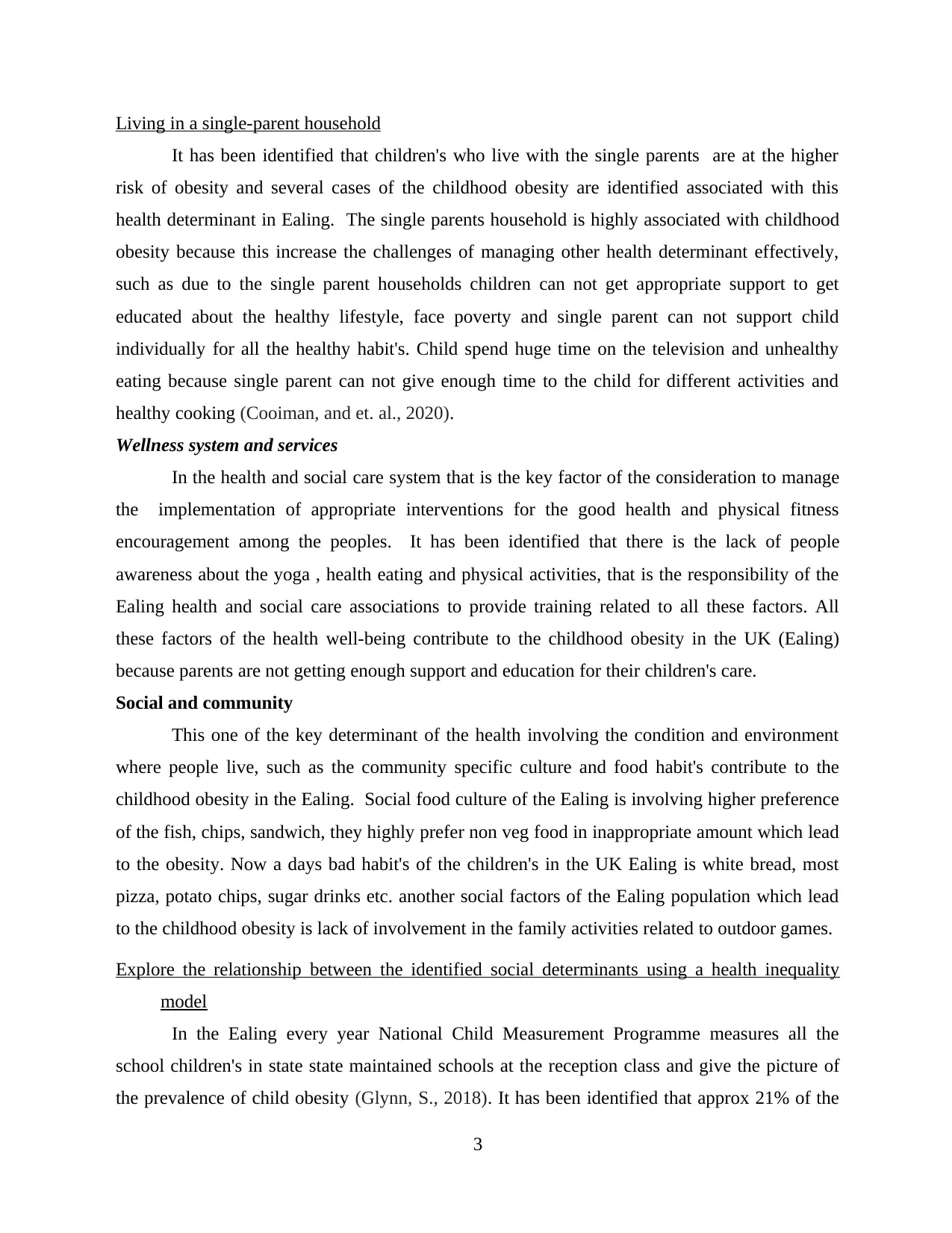
Living in a single-parent household
It has been identified that children's who live with the single parents are at the higher
risk of obesity and several cases of the childhood obesity are identified associated with this
health determinant in Ealing. The single parents household is highly associated with childhood
obesity because this increase the challenges of managing other health determinant effectively,
such as due to the single parent households children can not get appropriate support to get
educated about the healthy lifestyle, face poverty and single parent can not support child
individually for all the healthy habit's. Child spend huge time on the television and unhealthy
eating because single parent can not give enough time to the child for different activities and
healthy cooking (Cooiman, and et. al., 2020).
Wellness system and services
In the health and social care system that is the key factor of the consideration to manage
the implementation of appropriate interventions for the good health and physical fitness
encouragement among the peoples. It has been identified that there is the lack of people
awareness about the yoga , health eating and physical activities, that is the responsibility of the
Ealing health and social care associations to provide training related to all these factors. All
these factors of the health well-being contribute to the childhood obesity in the UK (Ealing)
because parents are not getting enough support and education for their children's care.
Social and community
This one of the key determinant of the health involving the condition and environment
where people live, such as the community specific culture and food habit's contribute to the
childhood obesity in the Ealing. Social food culture of the Ealing is involving higher preference
of the fish, chips, sandwich, they highly prefer non veg food in inappropriate amount which lead
to the obesity. Now a days bad habit's of the children's in the UK Ealing is white bread, most
pizza, potato chips, sugar drinks etc. another social factors of the Ealing population which lead
to the childhood obesity is lack of involvement in the family activities related to outdoor games.
Explore the relationship between the identified social determinants using a health inequality
model
In the Ealing every year National Child Measurement Programme measures all the
school children's in state state maintained schools at the reception class and give the picture of
the prevalence of child obesity (Glynn, S., 2018). It has been identified that approx 21% of the
3
It has been identified that children's who live with the single parents are at the higher
risk of obesity and several cases of the childhood obesity are identified associated with this
health determinant in Ealing. The single parents household is highly associated with childhood
obesity because this increase the challenges of managing other health determinant effectively,
such as due to the single parent households children can not get appropriate support to get
educated about the healthy lifestyle, face poverty and single parent can not support child
individually for all the healthy habit's. Child spend huge time on the television and unhealthy
eating because single parent can not give enough time to the child for different activities and
healthy cooking (Cooiman, and et. al., 2020).
Wellness system and services
In the health and social care system that is the key factor of the consideration to manage
the implementation of appropriate interventions for the good health and physical fitness
encouragement among the peoples. It has been identified that there is the lack of people
awareness about the yoga , health eating and physical activities, that is the responsibility of the
Ealing health and social care associations to provide training related to all these factors. All
these factors of the health well-being contribute to the childhood obesity in the UK (Ealing)
because parents are not getting enough support and education for their children's care.
Social and community
This one of the key determinant of the health involving the condition and environment
where people live, such as the community specific culture and food habit's contribute to the
childhood obesity in the Ealing. Social food culture of the Ealing is involving higher preference
of the fish, chips, sandwich, they highly prefer non veg food in inappropriate amount which lead
to the obesity. Now a days bad habit's of the children's in the UK Ealing is white bread, most
pizza, potato chips, sugar drinks etc. another social factors of the Ealing population which lead
to the childhood obesity is lack of involvement in the family activities related to outdoor games.
Explore the relationship between the identified social determinants using a health inequality
model
In the Ealing every year National Child Measurement Programme measures all the
school children's in state state maintained schools at the reception class and give the picture of
the prevalence of child obesity (Glynn, S., 2018). It has been identified that approx 21% of the
3
⊘ This is a preview!⊘
Do you want full access?
Subscribe today to unlock all pages.

Trusted by 1+ million students worldwide
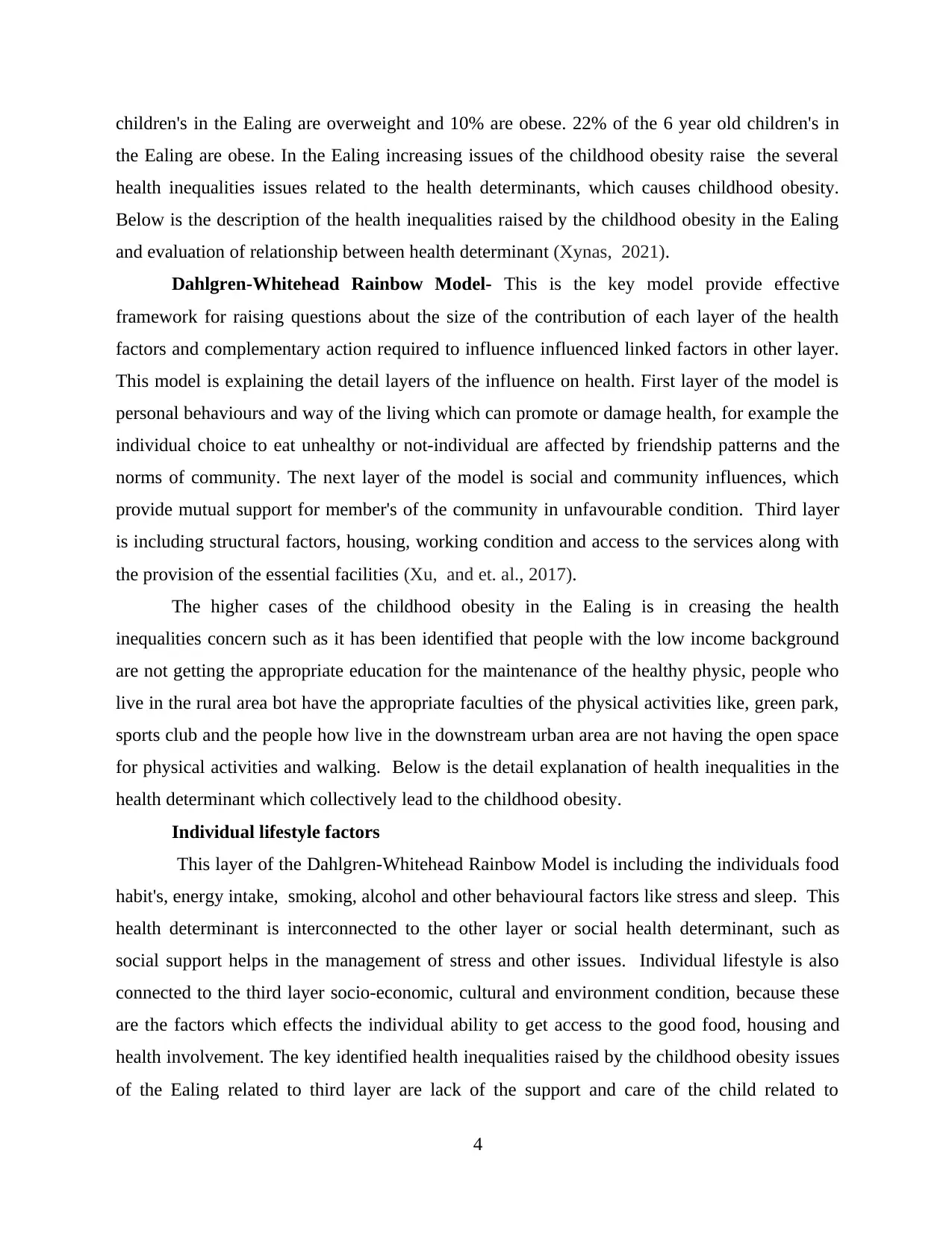
children's in the Ealing are overweight and 10% are obese. 22% of the 6 year old children's in
the Ealing are obese. In the Ealing increasing issues of the childhood obesity raise the several
health inequalities issues related to the health determinants, which causes childhood obesity.
Below is the description of the health inequalities raised by the childhood obesity in the Ealing
and evaluation of relationship between health determinant (Xynas, 2021).
Dahlgren-Whitehead Rainbow Model- This is the key model provide effective
framework for raising questions about the size of the contribution of each layer of the health
factors and complementary action required to influence influenced linked factors in other layer.
This model is explaining the detail layers of the influence on health. First layer of the model is
personal behaviours and way of the living which can promote or damage health, for example the
individual choice to eat unhealthy or not-individual are affected by friendship patterns and the
norms of community. The next layer of the model is social and community influences, which
provide mutual support for member's of the community in unfavourable condition. Third layer
is including structural factors, housing, working condition and access to the services along with
the provision of the essential facilities (Xu, and et. al., 2017).
The higher cases of the childhood obesity in the Ealing is in creasing the health
inequalities concern such as it has been identified that people with the low income background
are not getting the appropriate education for the maintenance of the healthy physic, people who
live in the rural area bot have the appropriate faculties of the physical activities like, green park,
sports club and the people how live in the downstream urban area are not having the open space
for physical activities and walking. Below is the detail explanation of health inequalities in the
health determinant which collectively lead to the childhood obesity.
Individual lifestyle factors
This layer of the Dahlgren-Whitehead Rainbow Model is including the individuals food
habit's, energy intake, smoking, alcohol and other behavioural factors like stress and sleep. This
health determinant is interconnected to the other layer or social health determinant, such as
social support helps in the management of stress and other issues. Individual lifestyle is also
connected to the third layer socio-economic, cultural and environment condition, because these
are the factors which effects the individual ability to get access to the good food, housing and
health involvement. The key identified health inequalities raised by the childhood obesity issues
of the Ealing related to third layer are lack of the support and care of the child related to
4
the Ealing are obese. In the Ealing increasing issues of the childhood obesity raise the several
health inequalities issues related to the health determinants, which causes childhood obesity.
Below is the description of the health inequalities raised by the childhood obesity in the Ealing
and evaluation of relationship between health determinant (Xynas, 2021).
Dahlgren-Whitehead Rainbow Model- This is the key model provide effective
framework for raising questions about the size of the contribution of each layer of the health
factors and complementary action required to influence influenced linked factors in other layer.
This model is explaining the detail layers of the influence on health. First layer of the model is
personal behaviours and way of the living which can promote or damage health, for example the
individual choice to eat unhealthy or not-individual are affected by friendship patterns and the
norms of community. The next layer of the model is social and community influences, which
provide mutual support for member's of the community in unfavourable condition. Third layer
is including structural factors, housing, working condition and access to the services along with
the provision of the essential facilities (Xu, and et. al., 2017).
The higher cases of the childhood obesity in the Ealing is in creasing the health
inequalities concern such as it has been identified that people with the low income background
are not getting the appropriate education for the maintenance of the healthy physic, people who
live in the rural area bot have the appropriate faculties of the physical activities like, green park,
sports club and the people how live in the downstream urban area are not having the open space
for physical activities and walking. Below is the detail explanation of health inequalities in the
health determinant which collectively lead to the childhood obesity.
Individual lifestyle factors
This layer of the Dahlgren-Whitehead Rainbow Model is including the individuals food
habit's, energy intake, smoking, alcohol and other behavioural factors like stress and sleep. This
health determinant is interconnected to the other layer or social health determinant, such as
social support helps in the management of stress and other issues. Individual lifestyle is also
connected to the third layer socio-economic, cultural and environment condition, because these
are the factors which effects the individual ability to get access to the good food, housing and
health involvement. The key identified health inequalities raised by the childhood obesity issues
of the Ealing related to third layer are lack of the support and care of the child related to
4
Paraphrase This Document
Need a fresh take? Get an instant paraphrase of this document with our AI Paraphraser
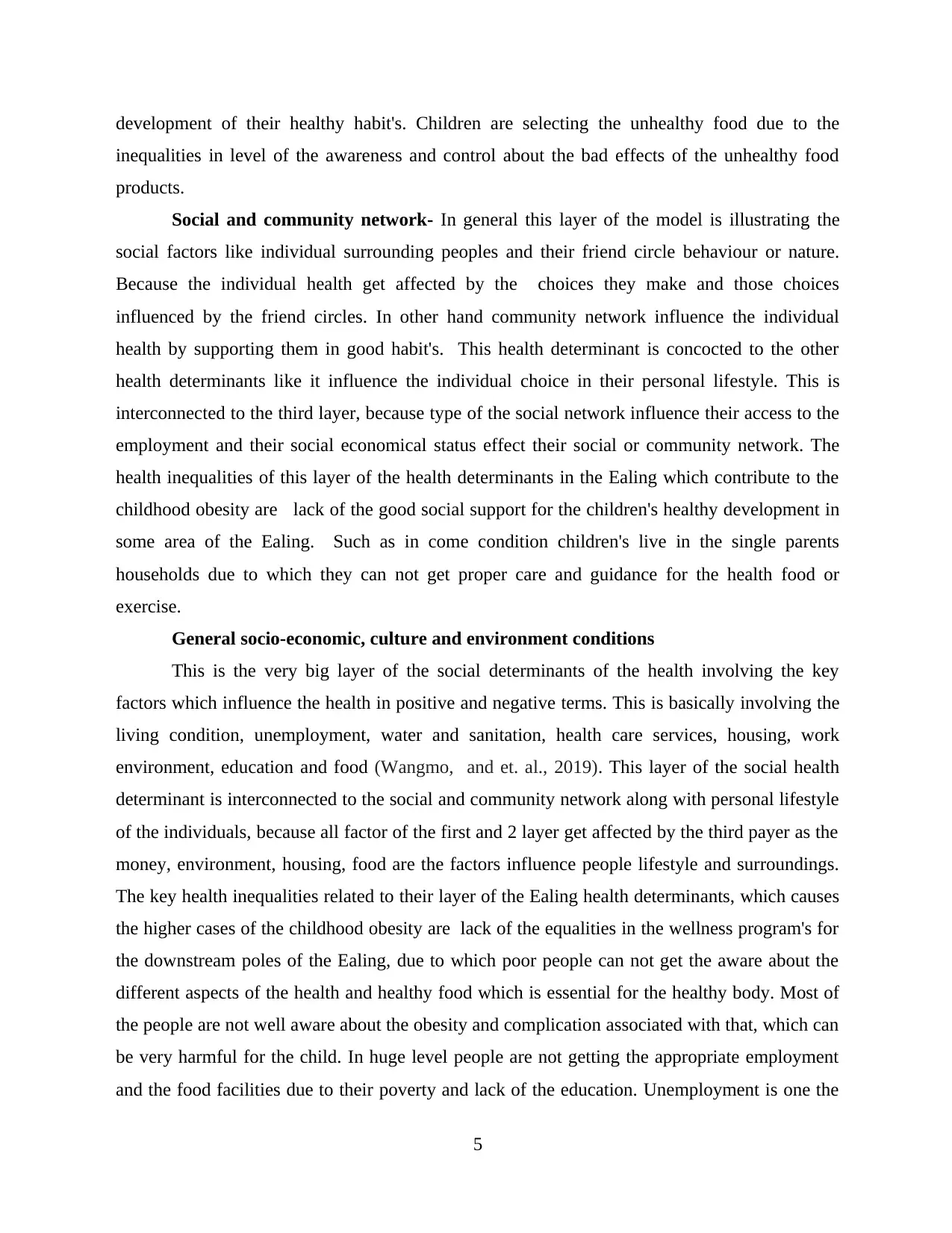
development of their healthy habit's. Children are selecting the unhealthy food due to the
inequalities in level of the awareness and control about the bad effects of the unhealthy food
products.
Social and community network- In general this layer of the model is illustrating the
social factors like individual surrounding peoples and their friend circle behaviour or nature.
Because the individual health get affected by the choices they make and those choices
influenced by the friend circles. In other hand community network influence the individual
health by supporting them in good habit's. This health determinant is concocted to the other
health determinants like it influence the individual choice in their personal lifestyle. This is
interconnected to the third layer, because type of the social network influence their access to the
employment and their social economical status effect their social or community network. The
health inequalities of this layer of the health determinants in the Ealing which contribute to the
childhood obesity are lack of the good social support for the children's healthy development in
some area of the Ealing. Such as in come condition children's live in the single parents
households due to which they can not get proper care and guidance for the health food or
exercise.
General socio-economic, culture and environment conditions
This is the very big layer of the social determinants of the health involving the key
factors which influence the health in positive and negative terms. This is basically involving the
living condition, unemployment, water and sanitation, health care services, housing, work
environment, education and food (Wangmo, and et. al., 2019). This layer of the social health
determinant is interconnected to the social and community network along with personal lifestyle
of the individuals, because all factor of the first and 2 layer get affected by the third payer as the
money, environment, housing, food are the factors influence people lifestyle and surroundings.
The key health inequalities related to their layer of the Ealing health determinants, which causes
the higher cases of the childhood obesity are lack of the equalities in the wellness program's for
the downstream poles of the Ealing, due to which poor people can not get the aware about the
different aspects of the health and healthy food which is essential for the healthy body. Most of
the people are not well aware about the obesity and complication associated with that, which can
be very harmful for the child. In huge level people are not getting the appropriate employment
and the food facilities due to their poverty and lack of the education. Unemployment is one the
5
inequalities in level of the awareness and control about the bad effects of the unhealthy food
products.
Social and community network- In general this layer of the model is illustrating the
social factors like individual surrounding peoples and their friend circle behaviour or nature.
Because the individual health get affected by the choices they make and those choices
influenced by the friend circles. In other hand community network influence the individual
health by supporting them in good habit's. This health determinant is concocted to the other
health determinants like it influence the individual choice in their personal lifestyle. This is
interconnected to the third layer, because type of the social network influence their access to the
employment and their social economical status effect their social or community network. The
health inequalities of this layer of the health determinants in the Ealing which contribute to the
childhood obesity are lack of the good social support for the children's healthy development in
some area of the Ealing. Such as in come condition children's live in the single parents
households due to which they can not get proper care and guidance for the health food or
exercise.
General socio-economic, culture and environment conditions
This is the very big layer of the social determinants of the health involving the key
factors which influence the health in positive and negative terms. This is basically involving the
living condition, unemployment, water and sanitation, health care services, housing, work
environment, education and food (Wangmo, and et. al., 2019). This layer of the social health
determinant is interconnected to the social and community network along with personal lifestyle
of the individuals, because all factor of the first and 2 layer get affected by the third payer as the
money, environment, housing, food are the factors influence people lifestyle and surroundings.
The key health inequalities related to their layer of the Ealing health determinants, which causes
the higher cases of the childhood obesity are lack of the equalities in the wellness program's for
the downstream poles of the Ealing, due to which poor people can not get the aware about the
different aspects of the health and healthy food which is essential for the healthy body. Most of
the people are not well aware about the obesity and complication associated with that, which can
be very harmful for the child. In huge level people are not getting the appropriate employment
and the food facilities due to their poverty and lack of the education. Unemployment is one the
5
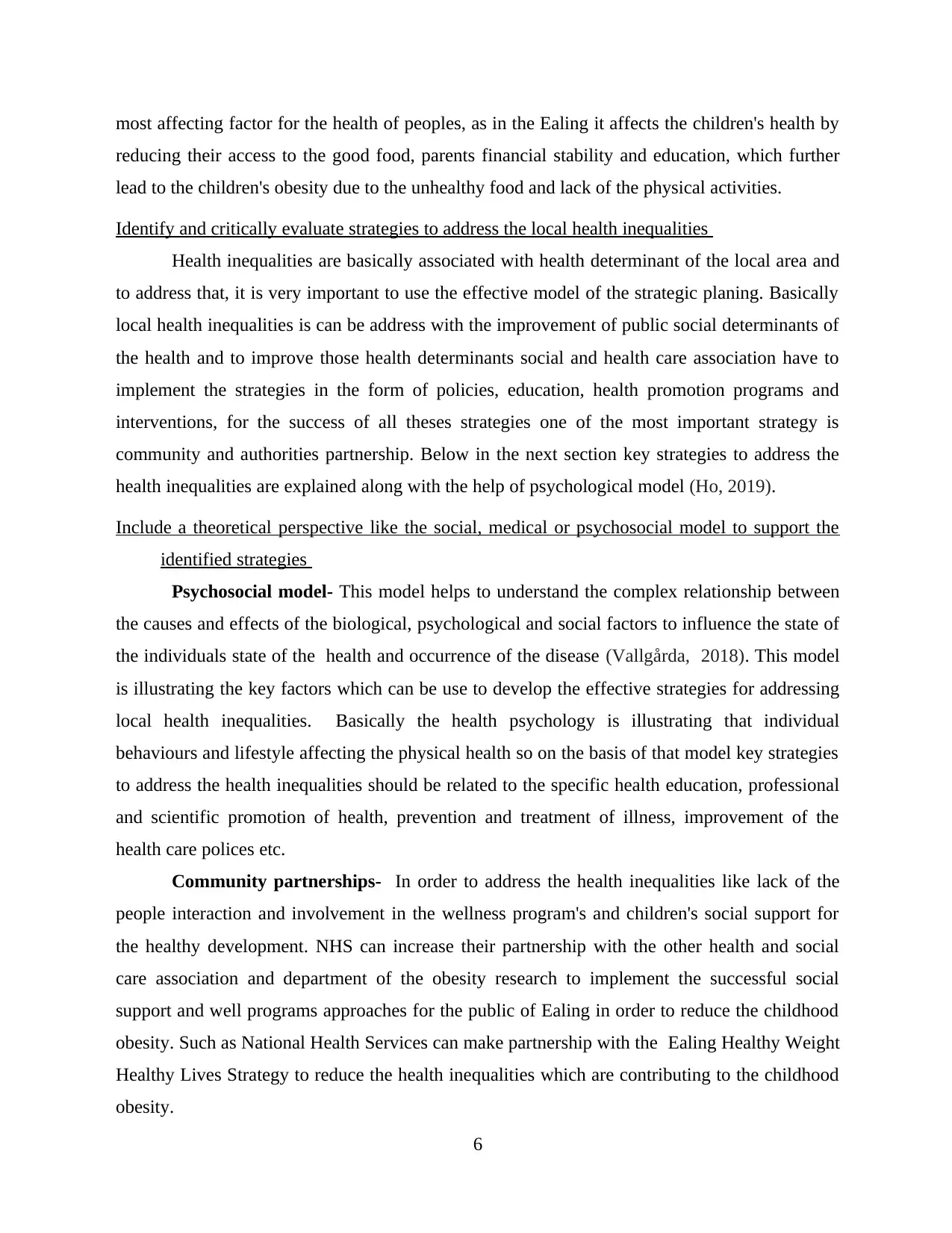
most affecting factor for the health of peoples, as in the Ealing it affects the children's health by
reducing their access to the good food, parents financial stability and education, which further
lead to the children's obesity due to the unhealthy food and lack of the physical activities.
Identify and critically evaluate strategies to address the local health inequalities
Health inequalities are basically associated with health determinant of the local area and
to address that, it is very important to use the effective model of the strategic planing. Basically
local health inequalities is can be address with the improvement of public social determinants of
the health and to improve those health determinants social and health care association have to
implement the strategies in the form of policies, education, health promotion programs and
interventions, for the success of all theses strategies one of the most important strategy is
community and authorities partnership. Below in the next section key strategies to address the
health inequalities are explained along with the help of psychological model (Ho, 2019).
Include a theoretical perspective like the social, medical or psychosocial model to support the
identified strategies
Psychosocial model- This model helps to understand the complex relationship between
the causes and effects of the biological, psychological and social factors to influence the state of
the individuals state of the health and occurrence of the disease (Vallgårda, 2018). This model
is illustrating the key factors which can be use to develop the effective strategies for addressing
local health inequalities. Basically the health psychology is illustrating that individual
behaviours and lifestyle affecting the physical health so on the basis of that model key strategies
to address the health inequalities should be related to the specific health education, professional
and scientific promotion of health, prevention and treatment of illness, improvement of the
health care polices etc.
Community partnerships- In order to address the health inequalities like lack of the
people interaction and involvement in the wellness program's and children's social support for
the healthy development. NHS can increase their partnership with the other health and social
care association and department of the obesity research to implement the successful social
support and well programs approaches for the public of Ealing in order to reduce the childhood
obesity. Such as National Health Services can make partnership with the Ealing Healthy Weight
Healthy Lives Strategy to reduce the health inequalities which are contributing to the childhood
obesity.
6
reducing their access to the good food, parents financial stability and education, which further
lead to the children's obesity due to the unhealthy food and lack of the physical activities.
Identify and critically evaluate strategies to address the local health inequalities
Health inequalities are basically associated with health determinant of the local area and
to address that, it is very important to use the effective model of the strategic planing. Basically
local health inequalities is can be address with the improvement of public social determinants of
the health and to improve those health determinants social and health care association have to
implement the strategies in the form of policies, education, health promotion programs and
interventions, for the success of all theses strategies one of the most important strategy is
community and authorities partnership. Below in the next section key strategies to address the
health inequalities are explained along with the help of psychological model (Ho, 2019).
Include a theoretical perspective like the social, medical or psychosocial model to support the
identified strategies
Psychosocial model- This model helps to understand the complex relationship between
the causes and effects of the biological, psychological and social factors to influence the state of
the individuals state of the health and occurrence of the disease (Vallgårda, 2018). This model
is illustrating the key factors which can be use to develop the effective strategies for addressing
local health inequalities. Basically the health psychology is illustrating that individual
behaviours and lifestyle affecting the physical health so on the basis of that model key strategies
to address the health inequalities should be related to the specific health education, professional
and scientific promotion of health, prevention and treatment of illness, improvement of the
health care polices etc.
Community partnerships- In order to address the health inequalities like lack of the
people interaction and involvement in the wellness program's and children's social support for
the healthy development. NHS can increase their partnership with the other health and social
care association and department of the obesity research to implement the successful social
support and well programs approaches for the public of Ealing in order to reduce the childhood
obesity. Such as National Health Services can make partnership with the Ealing Healthy Weight
Healthy Lives Strategy to reduce the health inequalities which are contributing to the childhood
obesity.
6
⊘ This is a preview!⊘
Do you want full access?
Subscribe today to unlock all pages.

Trusted by 1+ million students worldwide
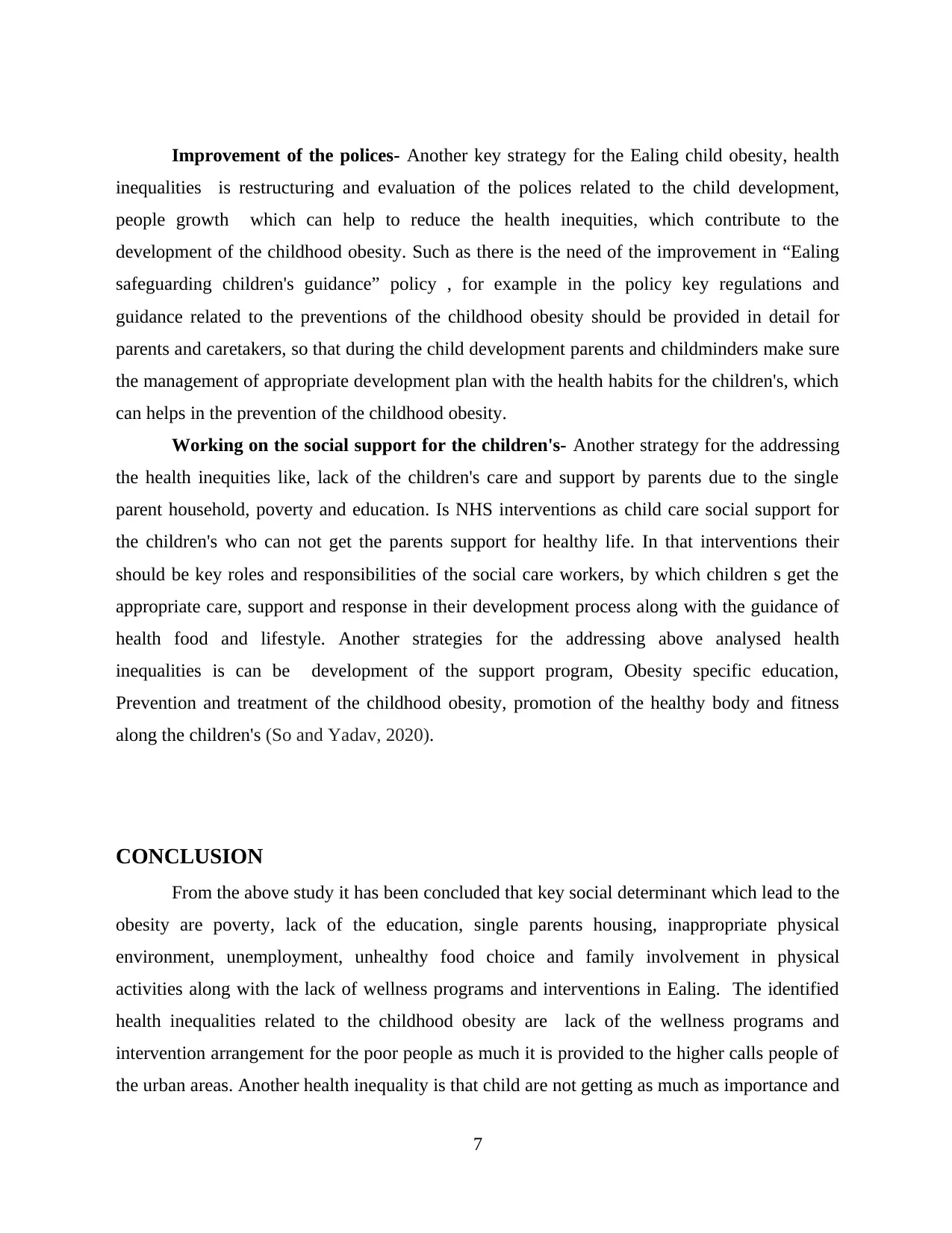
Improvement of the polices- Another key strategy for the Ealing child obesity, health
inequalities is restructuring and evaluation of the polices related to the child development,
people growth which can help to reduce the health inequities, which contribute to the
development of the childhood obesity. Such as there is the need of the improvement in “Ealing
safeguarding children's guidance” policy , for example in the policy key regulations and
guidance related to the preventions of the childhood obesity should be provided in detail for
parents and caretakers, so that during the child development parents and childminders make sure
the management of appropriate development plan with the health habits for the children's, which
can helps in the prevention of the childhood obesity.
Working on the social support for the children's- Another strategy for the addressing
the health inequities like, lack of the children's care and support by parents due to the single
parent household, poverty and education. Is NHS interventions as child care social support for
the children's who can not get the parents support for healthy life. In that interventions their
should be key roles and responsibilities of the social care workers, by which children s get the
appropriate care, support and response in their development process along with the guidance of
health food and lifestyle. Another strategies for the addressing above analysed health
inequalities is can be development of the support program, Obesity specific education,
Prevention and treatment of the childhood obesity, promotion of the healthy body and fitness
along the children's (So and Yadav, 2020).
CONCLUSION
From the above study it has been concluded that key social determinant which lead to the
obesity are poverty, lack of the education, single parents housing, inappropriate physical
environment, unemployment, unhealthy food choice and family involvement in physical
activities along with the lack of wellness programs and interventions in Ealing. The identified
health inequalities related to the childhood obesity are lack of the wellness programs and
intervention arrangement for the poor people as much it is provided to the higher calls people of
the urban areas. Another health inequality is that child are not getting as much as importance and
7
inequalities is restructuring and evaluation of the polices related to the child development,
people growth which can help to reduce the health inequities, which contribute to the
development of the childhood obesity. Such as there is the need of the improvement in “Ealing
safeguarding children's guidance” policy , for example in the policy key regulations and
guidance related to the preventions of the childhood obesity should be provided in detail for
parents and caretakers, so that during the child development parents and childminders make sure
the management of appropriate development plan with the health habits for the children's, which
can helps in the prevention of the childhood obesity.
Working on the social support for the children's- Another strategy for the addressing
the health inequities like, lack of the children's care and support by parents due to the single
parent household, poverty and education. Is NHS interventions as child care social support for
the children's who can not get the parents support for healthy life. In that interventions their
should be key roles and responsibilities of the social care workers, by which children s get the
appropriate care, support and response in their development process along with the guidance of
health food and lifestyle. Another strategies for the addressing above analysed health
inequalities is can be development of the support program, Obesity specific education,
Prevention and treatment of the childhood obesity, promotion of the healthy body and fitness
along the children's (So and Yadav, 2020).
CONCLUSION
From the above study it has been concluded that key social determinant which lead to the
obesity are poverty, lack of the education, single parents housing, inappropriate physical
environment, unemployment, unhealthy food choice and family involvement in physical
activities along with the lack of wellness programs and interventions in Ealing. The identified
health inequalities related to the childhood obesity are lack of the wellness programs and
intervention arrangement for the poor people as much it is provided to the higher calls people of
the urban areas. Another health inequality is that child are not getting as much as importance and
7
Paraphrase This Document
Need a fresh take? Get an instant paraphrase of this document with our AI Paraphraser
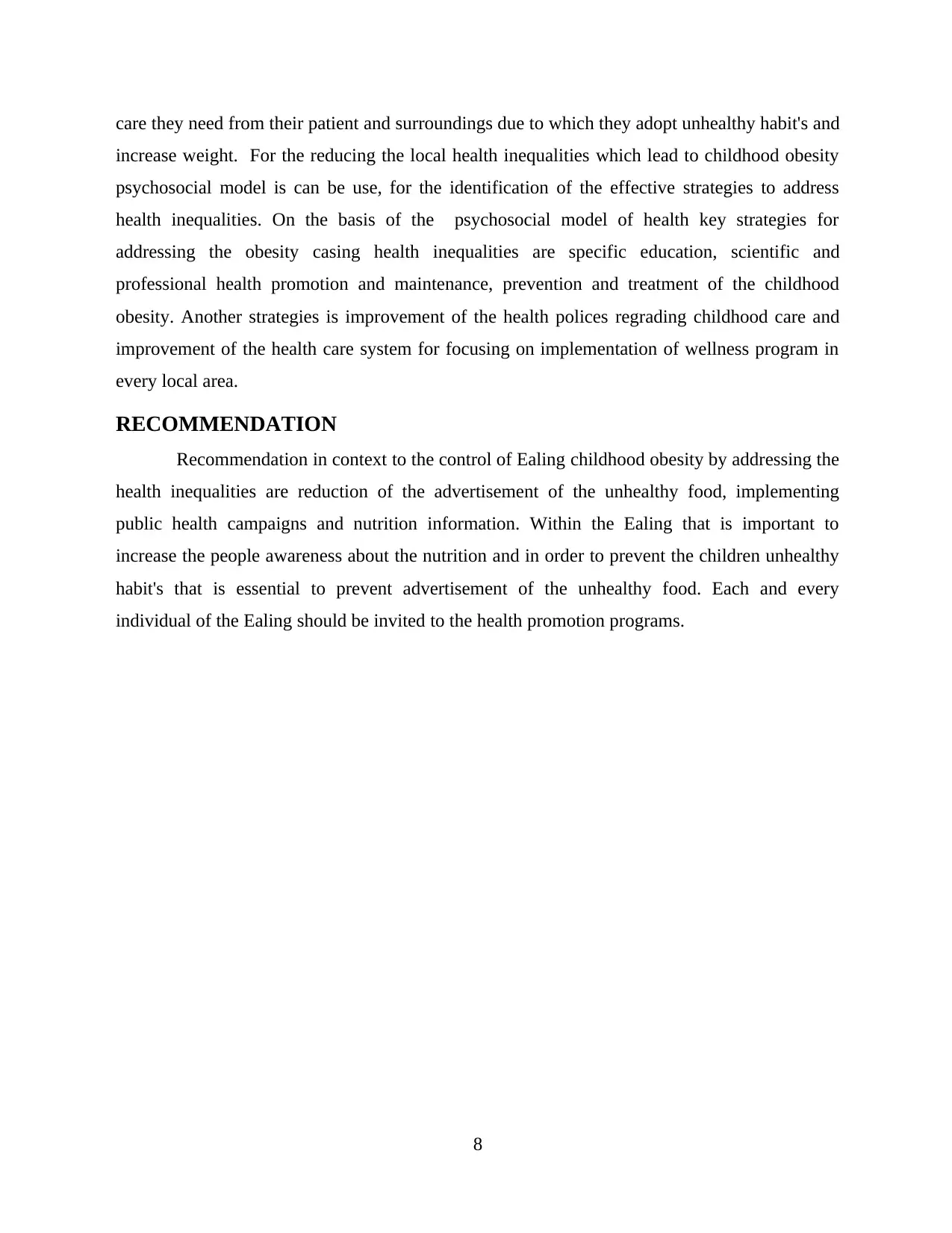
care they need from their patient and surroundings due to which they adopt unhealthy habit's and
increase weight. For the reducing the local health inequalities which lead to childhood obesity
psychosocial model is can be use, for the identification of the effective strategies to address
health inequalities. On the basis of the psychosocial model of health key strategies for
addressing the obesity casing health inequalities are specific education, scientific and
professional health promotion and maintenance, prevention and treatment of the childhood
obesity. Another strategies is improvement of the health polices regrading childhood care and
improvement of the health care system for focusing on implementation of wellness program in
every local area.
RECOMMENDATION
Recommendation in context to the control of Ealing childhood obesity by addressing the
health inequalities are reduction of the advertisement of the unhealthy food, implementing
public health campaigns and nutrition information. Within the Ealing that is important to
increase the people awareness about the nutrition and in order to prevent the children unhealthy
habit's that is essential to prevent advertisement of the unhealthy food. Each and every
individual of the Ealing should be invited to the health promotion programs.
8
increase weight. For the reducing the local health inequalities which lead to childhood obesity
psychosocial model is can be use, for the identification of the effective strategies to address
health inequalities. On the basis of the psychosocial model of health key strategies for
addressing the obesity casing health inequalities are specific education, scientific and
professional health promotion and maintenance, prevention and treatment of the childhood
obesity. Another strategies is improvement of the health polices regrading childhood care and
improvement of the health care system for focusing on implementation of wellness program in
every local area.
RECOMMENDATION
Recommendation in context to the control of Ealing childhood obesity by addressing the
health inequalities are reduction of the advertisement of the unhealthy food, implementing
public health campaigns and nutrition information. Within the Ealing that is important to
increase the people awareness about the nutrition and in order to prevent the children unhealthy
habit's that is essential to prevent advertisement of the unhealthy food. Each and every
individual of the Ealing should be invited to the health promotion programs.
8
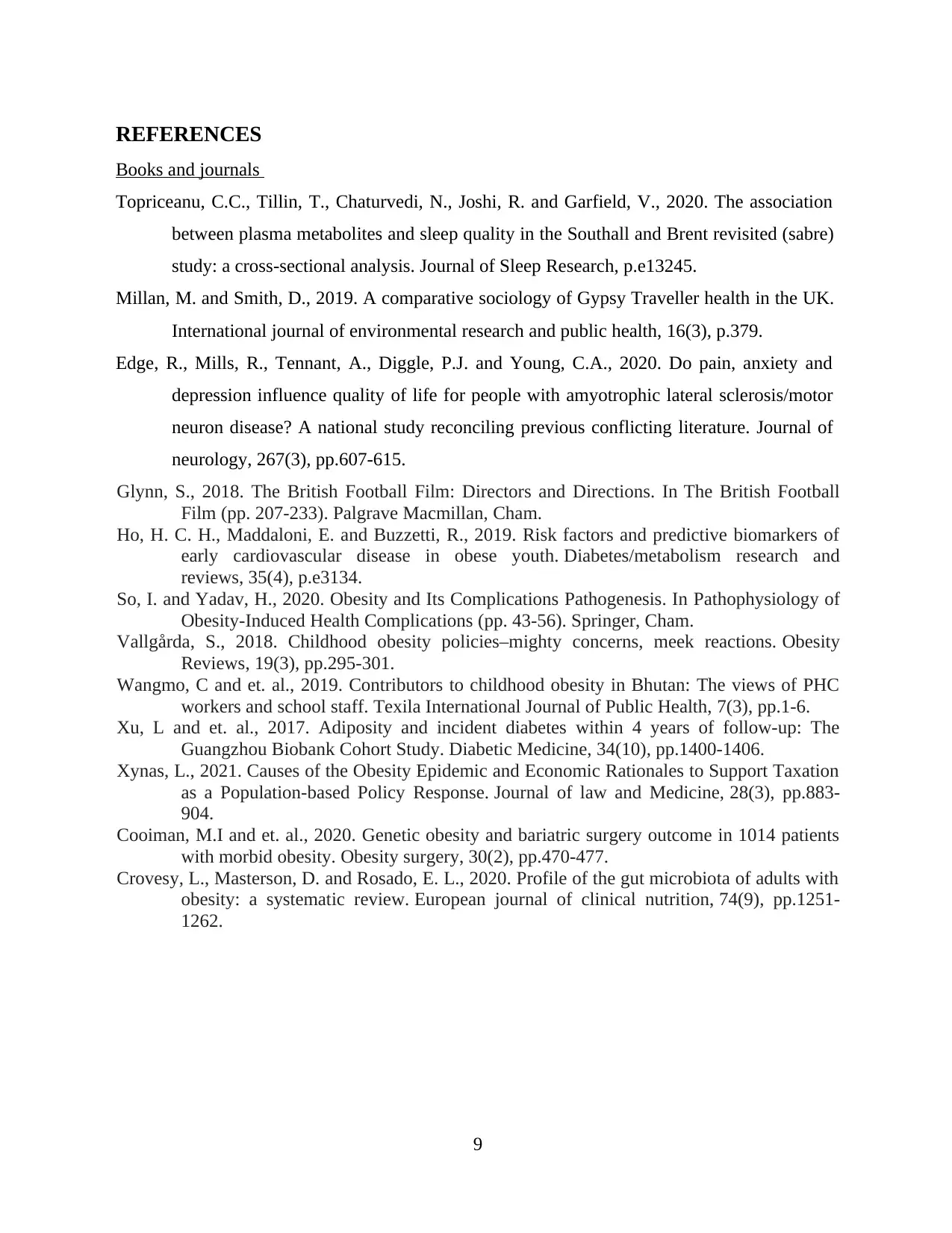
REFERENCES
Books and journals
Topriceanu, C.C., Tillin, T., Chaturvedi, N., Joshi, R. and Garfield, V., 2020. The association
between plasma metabolites and sleep quality in the Southall and Brent revisited (sabre)
study: a cross‐sectional analysis. Journal of Sleep Research, p.e13245.
Millan, M. and Smith, D., 2019. A comparative sociology of Gypsy Traveller health in the UK.
International journal of environmental research and public health, 16(3), p.379.
Edge, R., Mills, R., Tennant, A., Diggle, P.J. and Young, C.A., 2020. Do pain, anxiety and
depression influence quality of life for people with amyotrophic lateral sclerosis/motor
neuron disease? A national study reconciling previous conflicting literature. Journal of
neurology, 267(3), pp.607-615.
Glynn, S., 2018. The British Football Film: Directors and Directions. In The British Football
Film (pp. 207-233). Palgrave Macmillan, Cham.
Ho, H. C. H., Maddaloni, E. and Buzzetti, R., 2019. Risk factors and predictive biomarkers of
early cardiovascular disease in obese youth. Diabetes/metabolism research and
reviews, 35(4), p.e3134.
So, I. and Yadav, H., 2020. Obesity and Its Complications Pathogenesis. In Pathophysiology of
Obesity-Induced Health Complications (pp. 43-56). Springer, Cham.
Vallgårda, S., 2018. Childhood obesity policies–mighty concerns, meek reactions. Obesity
Reviews, 19(3), pp.295-301.
Wangmo, C and et. al., 2019. Contributors to childhood obesity in Bhutan: The views of PHC
workers and school staff. Texila International Journal of Public Health, 7(3), pp.1-6.
Xu, L and et. al., 2017. Adiposity and incident diabetes within 4 years of follow‐up: The
Guangzhou Biobank Cohort Study. Diabetic Medicine, 34(10), pp.1400-1406.
Xynas, L., 2021. Causes of the Obesity Epidemic and Economic Rationales to Support Taxation
as a Population-based Policy Response. Journal of law and Medicine, 28(3), pp.883-
904.
Cooiman, M.I and et. al., 2020. Genetic obesity and bariatric surgery outcome in 1014 patients
with morbid obesity. Obesity surgery, 30(2), pp.470-477.
Crovesy, L., Masterson, D. and Rosado, E. L., 2020. Profile of the gut microbiota of adults with
obesity: a systematic review. European journal of clinical nutrition, 74(9), pp.1251-
1262.
9
Books and journals
Topriceanu, C.C., Tillin, T., Chaturvedi, N., Joshi, R. and Garfield, V., 2020. The association
between plasma metabolites and sleep quality in the Southall and Brent revisited (sabre)
study: a cross‐sectional analysis. Journal of Sleep Research, p.e13245.
Millan, M. and Smith, D., 2019. A comparative sociology of Gypsy Traveller health in the UK.
International journal of environmental research and public health, 16(3), p.379.
Edge, R., Mills, R., Tennant, A., Diggle, P.J. and Young, C.A., 2020. Do pain, anxiety and
depression influence quality of life for people with amyotrophic lateral sclerosis/motor
neuron disease? A national study reconciling previous conflicting literature. Journal of
neurology, 267(3), pp.607-615.
Glynn, S., 2018. The British Football Film: Directors and Directions. In The British Football
Film (pp. 207-233). Palgrave Macmillan, Cham.
Ho, H. C. H., Maddaloni, E. and Buzzetti, R., 2019. Risk factors and predictive biomarkers of
early cardiovascular disease in obese youth. Diabetes/metabolism research and
reviews, 35(4), p.e3134.
So, I. and Yadav, H., 2020. Obesity and Its Complications Pathogenesis. In Pathophysiology of
Obesity-Induced Health Complications (pp. 43-56). Springer, Cham.
Vallgårda, S., 2018. Childhood obesity policies–mighty concerns, meek reactions. Obesity
Reviews, 19(3), pp.295-301.
Wangmo, C and et. al., 2019. Contributors to childhood obesity in Bhutan: The views of PHC
workers and school staff. Texila International Journal of Public Health, 7(3), pp.1-6.
Xu, L and et. al., 2017. Adiposity and incident diabetes within 4 years of follow‐up: The
Guangzhou Biobank Cohort Study. Diabetic Medicine, 34(10), pp.1400-1406.
Xynas, L., 2021. Causes of the Obesity Epidemic and Economic Rationales to Support Taxation
as a Population-based Policy Response. Journal of law and Medicine, 28(3), pp.883-
904.
Cooiman, M.I and et. al., 2020. Genetic obesity and bariatric surgery outcome in 1014 patients
with morbid obesity. Obesity surgery, 30(2), pp.470-477.
Crovesy, L., Masterson, D. and Rosado, E. L., 2020. Profile of the gut microbiota of adults with
obesity: a systematic review. European journal of clinical nutrition, 74(9), pp.1251-
1262.
9
⊘ This is a preview!⊘
Do you want full access?
Subscribe today to unlock all pages.

Trusted by 1+ million students worldwide
1 out of 12
Related Documents
Your All-in-One AI-Powered Toolkit for Academic Success.
+13062052269
info@desklib.com
Available 24*7 on WhatsApp / Email
![[object Object]](/_next/static/media/star-bottom.7253800d.svg)
Unlock your academic potential
Copyright © 2020–2025 A2Z Services. All Rights Reserved. Developed and managed by ZUCOL.





